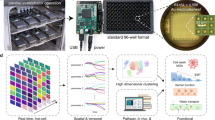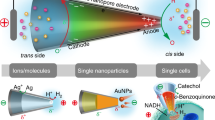Abstract
Platforms that offer massively parallel, label-free biosensing can, in principle, be created by combining all-electrical detection with low-cost integrated circuits. Examples include field-effect transistor arrays, which are used for mapping neuronal signals1,2 and sequencing DNA3,4. Despite these successes, however, bioelectronics has so far failed to deliver a broadly applicable biosensing platform. This is due, in part, to the fact that d.c. or low-frequency signals cannot be used to probe beyond the electrical double layer formed by screening salt ions5,6,7,8, which means that under physiological conditions the sensing of a target analyte located even a short distance from the sensor (∼1 nm) is severely hampered. Here, we show that high-frequency impedance spectroscopy can be used to detect and image microparticles and living cells under physiological salt conditions. Our assay employs a large-scale, high-density array of nanoelectrodes integrated with CMOS electronics on a single chip and the sensor response depends on the electrical properties of the analyte, allowing impedance-based fingerprinting. With our platform, we image the dynamic attachment and micromotion of BEAS, THP1 and MCF7 cancer cell lines in real time at submicrometre resolution in growth medium, demonstrating the potential of the platform for label/tracer-free high-throughput screening of anti-tumour drug candidates.
This is a preview of subscription content, access via your institution
Access options
Subscribe to this journal
Receive 12 print issues and online access
$259.00 per year
only $21.58 per issue
Buy this article
- Purchase on Springer Link
- Instant access to full article PDF
Prices may be subject to local taxes which are calculated during checkout




Similar content being viewed by others
References
Fromherz, P., Offenhäusser, A., Vetter, T. & Weis, J. A neuron–silicon junction: a Retzius cell of the leech on an insulated-gate field-effect transistor. Science 252, 1290–1293 (1991).
Eversmann, B. et al. A 128 × 128 CMOS biosensor array for extracellular recording of neural activity. IEEE J. Solid-State Circuits 38, 2306–2317 (2003).
Rothberg, J. M. et al. An integrated semiconductor device enabling non-optical genome sequencing. Nature 475, 348–352 (2011).
Toumazou, C. et al. Simultaneous DNA amplification and detection using a pH-sensing semiconductor system. Nature Methods 10, 641–646 (2013).
Matsumoto, A. & Miyahara, Y. Current and emerging challenges of field effect transistor based bio-sensing. Nanoscale 5, 10702–10718 (2013).
Nair, P. R. & Alam, M. A. Screening-limited response of nanobiosensors. Nano Lett. 8, 1281–1285 (2008).
Rajan, N. K., Duan, X. & Reed, M. A. Performance limitations for nanowire/nanoribbon biosensors. Rev. Nanomed. Nanobiotechnol. 5, 629–645 (2013).
Stern, E. et al. Importance of the Debye screening length on nanowire field effect transistor sensors. Nano Lett. 7, 3405–3409 (2007).
Kulkarni, G. S. & Zhong, Z. Detection beyond the Debye screening length in a high-frequency nanoelectronic biosensor. Nano Lett. 12, 719–723 (2012).
Woo, J. M. et al. Modulation of molecular hybridization and charge screening in a carbon nanotube network channel using the electrical pulse method. Lab. Chip 13, 3755–3763 (2013).
Giaever, I. & Keese, C. R. A morphological biosensor for mammalian cells. Nature 366, 591–592 (1993).
Wong, C. C. et al. CMOS based high density micro array platform for electrochemical detection and enumeration of cells. Tech. Dig. Int. Electron Dev. Meeting 14.2.1–14.2.4 (2013).
Stern, E. et al. Label-free immunodetection with CMOS-compatible semiconducting nanowires. Nature 445, 519–522 (2007).
Bard, A. J. & Faulkner, L. R. Electrochemical Methods: Fundamentals and Applications 2nd edn (Wiley, 1980).
Pittino, F. & Selmi, L. Use and comparative assessment of the CVFEM method for Poisson–Boltzmann and Poisson–Nernst–Planck three dimensional simulations of impedimetric nano-biosensors operated in the DC and AC small signal regimes. Comput. Methods Appl. Mech. Eng. 278, 902–923 (2014).
Lasia, A. Electrochemical Impedance Spectroscopy and its Applications (Springer, 2014).
Debye, P. & Hückel, E. Zur theorie der elektrolyte. I. Gefrierpunktserniedrigung und verwandte erscheinungen. The theory of electrolytes. I. Lowering of freezing point and related phenomena. Physik. Z. 24, 185–206 (1923).
Cui, Y., Wei, Q., Park, H. & Lieber, C. M. Nanowire nanosensors for highly sensitive and selective detection of biological and chemical species. Science 293, 1289–1292 (2001).
Patolsky, F. et al. Detection, stimulation, and inhibition of neuronal signals with high-density nanowire transistor arrays. Science 313, 1100–1104 (2006).
Daniels, J. S. & Pourmand, N. Label-free impedance biosensors: opportunities and challenges. Electroanalysis 19, 1239–1257 (2007).
Lorrain, P., Corson, D. P. & Lorrain, F. Electromagnetic Fields and Waves 3rd edn (W. H. Freeman, 1988).
Klein, E. et al. Properties of the K562 cell line, derived from a patient with chronic myeloid leukemia. Int. J. Cancer 18, 421–431 (1976).
Solsona, C., Innocenti, B. & Fernández, J. M. Regulation of exocytotic fusion by cell inflation. Biophys. J. 74, 1061–1073 (1998).
Asara, Y. et al. Cadmium influences the 5-fluorouracil cytotoxic effects on breast cancer cells. Eur. J. Histochem. 56, 1–6 (2012).
Goicoechea, S. M. et al. Palladin contributes to invasive motility in human breast cancer cells. Oncogene 28, 587–598 (2008).
Verhoeven, H. A. & Van Griensven, L. J. L. D. Flow cytometric evaluation of the effects of 3-bromopyruvate (3BP) and dichloracetate (DCA) on THP-1 cells: a multiparameter analysis. J. Bioenerg. Biomembr. 44, 91–99 (2012).
Susloparova, A., Koppenhöfer, D., Vu, X. T., Weil, M. & Ingebrandt, S. Impedance spectroscopy with field-effect transistor arrays for the analysis of anti-cancer drug action on individual cells. Biosens. Bioelectr. 40, 50–56 (2010).
Yan, W. et al. Increased invasion and tumorigenicity capacity of CD44+/CD24– breast cancer MCF7 cells in vitro and in nude mice. Cancer Cell Int. 13, 62 (2013).
Widdershoven, F. et al. CMOS biosensor platform. Tech. Dig. Int. Electron Dev. Meeting 36.1.1–36.1.4 (2010).
Acknowledgements
C.L. and S.G.L. acknowledge financial support from the European Research Council. F.P. and L.S. acknowledge financial support from the EU NANOFUNCTION project (FP7-ICT, no. 257375) and the MIUR Cooperlink project. M.A.J., H.V. and F.P.W. acknowledge financial support from NanoNextNL, a micro- and nanotechnology consortium of the Government of the Netherlands and 130 partners. F.P.W. thanks E. Sterckx, K. Verheyden, D. van Steenwinckel and R. Hendricksen for technical support.
Author information
Authors and Affiliations
Contributions
C.L., S.G.L. and F.P.W. designed the microparticle experiments and C.L. performed them. F.P., L.S. and F.P.W. developed the numerical simulation code and F.P. executed the simulations. H.V., M.A.J. and F.P.W. designed the experiments on living cells and H.V. performed them. C.L. processed the experimental data and simulation results for the manuscript. All authors contributed to the interpretation of the results and assisted in writing the manuscript.
Corresponding author
Ethics declarations
Competing interests
F.P.W declares the following financial interest. He is the (co-)inventor of multiple patents on which the CMOS nanocapacitor platform is based and is employed by NXP, where it was developed. The other authors declare no competing interests.
Supplementary information
Supplementary information
Supplementary Information (PDF 584 kb)
Supplementary Movie 1
Supplementary Movie 1 (MOV 9053 kb)
Rights and permissions
About this article
Cite this article
Laborde, C., Pittino, F., Verhoeven, H. et al. Real-time imaging of microparticles and living cells with CMOS nanocapacitor arrays. Nature Nanotech 10, 791–795 (2015). https://doi.org/10.1038/nnano.2015.163
Received:
Accepted:
Published:
Issue Date:
DOI: https://doi.org/10.1038/nnano.2015.163
This article is cited by
-
CMOS based capacitive sensor matrix for characterizing and tracking of biological cells
Scientific Reports (2022)
-
Biologically Sensitive FETs: Holistic Design Considerations from Simulation, Modeling and Fabrication Perspectives
Silicon (2022)
-
A Low-Power CMOS Microfluidic Pump Based on Travelling-Wave Electroosmosis for Diluted Serum Pumping
Scientific Reports (2019)
-
The influence of geometry and other fundamental challenges for bio-sensing with field effect transistors
Biophysical Reviews (2019)
-
Ultrasensitive detection of Ebola matrix protein in a memristor mode
Nano Research (2018)



